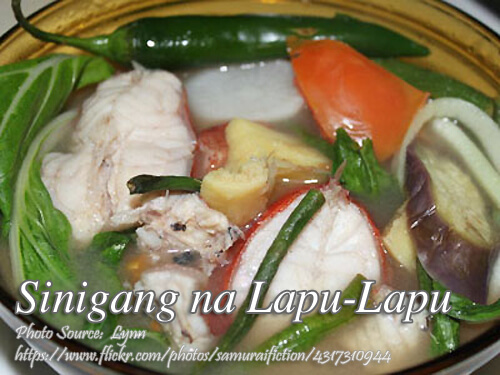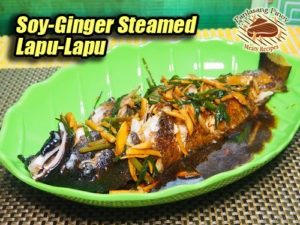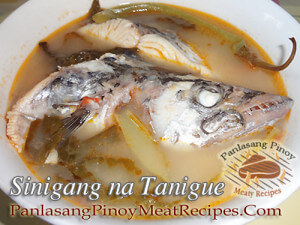Lapu-lapu or grouper is common in the Philippine wet market and the varieties of colors ranges from spotted red, red-orange, brown and gray with black spots. Although this is not rare, the only restriction from buying this fish is the price. It is expensive compared to other fishes sold in the market.
However you can try this sinigang na lapu-lapu recipe using tamarind juice to make a sour broth on some occasions or if you are just wondering what will a lapu-lapu with it’s white, flaky, and delicious meat would taste like in a sour tamarind based broth.
A Family Favorite with a Special Twist
Growing up, Sinigang was always a dish that made its way to our family table, especially during rainy afternoons. The tangy, savory broth, paired with rice, was like a warm hug in a bowl. But when my uncle first introduced us to the idea of using lapu-lapu (grouper) instead of the usual pork or shrimp, it added an air of elegance and novelty to the dish. Lapu-lapu’s delicate, flaky meat soaked up the sour tamarind broth in ways I hadn’t experienced before. It’s not a dish we made every day—lapu-lapu is one of the more expensive fish in the market—but when we did, it felt like a special occasion.
A Staple in Filipino Wet Markets
Lapu-lapu, also known as grouper, is a common find in most Philippine wet markets. You can recognize them by their variety of colors, ranging from a vibrant spotted red to subtler shades of brown and gray. My sister, who used to live near the coast, would always bring home a fresh catch when she visited, and we’d savor it together, either grilled or made into this comforting sour broth. But truth be told, its price often makes it more of a luxury, reserved for when you want to elevate a simple family meal.
What makes lapu-lapu so special in this dish is its white, flaky meat that pairs beautifully with the tart tamarind broth. While you can make sinigang with just about any fish, the richness and texture of lapu-lapu give it a different level of sophistication. It’s a perfect choice if you’re looking to impress guests or simply treat yourself to something a bit more indulgent.
The Magic of Tamarind Broth
Sinigang is one of those dishes that thrives on simplicity. The key to a great bowl of this comforting soup is, of course, the broth. Tamarind, or “sampalok,” has long been used in the Philippines to impart that characteristic sourness to sinigang, but there’s a bit of history behind it too. Some say that sour dishes like this became popular because the acidity helped preserve the food in tropical climates before refrigeration was widely available. Whether that’s true or not, there’s no denying the timeless appeal of a well-balanced sinigang broth.
Whenever I make this at home, I always start with fresh tamarind when I can find it. My aunt used to tell me that the secret to a flavorful broth is letting the tamarind pulp steep long enough to extract all the flavors. If you’re short on time, sinigang mix is a good alternative, but nothing beats the depth of flavor from freshly made tamarind juice. Tomatoes and onions simmered in the broth help build layers of flavor before the fish is added, and the scent of simmering broth always brings back memories of family dinners at home.
Cooking the Fish to Perfection
Cooking lapu-lapu in sinigang is incredibly straightforward, but it does require a bit of care. I remember the first time I made this dish, I was so worried about overcooking the fish. My uncle, a seasoned fisherman, gave me a piece of advice: don’t rush it. Fish cooks quickly, and lapu-lapu, with its tender meat, only needs about 8 to 10 minutes of simmering. The key is to add it only after your broth has reached the right balance of sourness and umami from the tomatoes, tamarind, and seasonings.
For those who like a little heat, I recommend tossing in a couple of green chilies toward the end. My mom would always add these when I was growing up, and it gives the broth a subtle warmth without overpowering the delicate flavor of the fish.
Vegetables That Complete the Dish
No sinigang is complete without its supporting cast of vegetables. My personal favorite combo includes kangkong (water spinach), eggplant, and sitaw (long beans). These veggies soak up the tangy broth while still retaining their own textures and flavors. Each bite offers something different—soft greens, slightly chewy beans, or the sponge-like eggplant that bursts with flavor.
The variety of vegetables also adds a layer of nutrition to the dish, making it both comforting and wholesome. My grandma used to tell us how, back in her day, she would use whatever veggies they had on hand in their garden. In that way, sinigang was both a practical and versatile dish that could stretch out to feed the whole family.
A Touch of Filipino Comfort
To really complete the experience, I always serve this fish stew with a dipping sauce of fish sauce mixed with calamansi juice and red chilies. It’s a simple touch, but it brings out the delicate flavor of the fish even more. I have fond memories of my cousins and me racing to dip our fish in this zesty sauce, trying to get just the right balance of salty and sour in each bite.
There’s something truly comforting about a bowl of this soup on a cool evening. For me, it’s not just about the taste—it’s the memories tied to it. Sinigang is one of those dishes that evokes a sense of home. Whether it was made with pork, shrimp, or lapu-lapu, it always brought our family together around the table, sharing stories while savoring the warmth of the broth.
So, if you’re curious about how lapu-lapu tastes in a sinigang, I encourage you to try it at least once. It’s a simple dish, but the flavors are rich, the memories it can create are even richer.
How to Cook Sinigang na Lapu-Lapu (Grouper in Sour Broth)
Ingredients
- 1 kilo medium size lapu lapu
- 1 medium size onion quartered
- 2 medium size tomato quartered
- 1 bundle kangkong leaves or any leafy vegetables take only the leaves and leaf stalk then discard the main stem
- 1 cup string beans cut into 1 & 1/2 inch long
- 5 pcs okra
- 1 inch ginger chopped
- 1 medium size white radish sliced into rounds
- 1 small eggplant sliced
- 1 cup tamarind juice boil tamarind, about 300 grams to 2 cups water or 2 tbsp. sampalok sinigang mix
- 4 pcs large green chilis or siling pansigang
- Patis or fish sauce or rock salt or iodized table salt
Instructions
How to cook Sinigang na lapu-lapu:
- Clean the lapu-lapu by removing the gills and internal organs. Wash in running water and slice into 1 to 2 inches wide.
- In a large pot pour 6 to 8 cups water and bring to a boil then add onions, tomatoes and tamarind juice (or sinigang mix) and simmer for at least 3 to 5 minutes.
- Then add the fish and let it simmer again for another 8 to 10 minutes or until the fish is already cooked.
- Season with salt or patis. You can add some magic sarap, namnam or any other granulated seasonings in the market.
- Then add the all the vegetables and green chili then cook for 2 to 3 minutes.
- Serve hot with fish sauce, kalamansi and red chili for dipping.
Notes
Cooking Tips:
Use Fresh Tamarind for a Richer Broth
While sinigang mix is convenient, using fresh tamarind gives the broth a deeper and more authentic sourness. Simply boil the tamarind pods in water, then mash and strain the juice into your pot. The extra effort is worth it for that fresh, tangy flavor that brings out the best in the fish.Add the Fish Last to Prevent Overcooking
Lapu-lapu has delicate, flaky meat, so it’s important to avoid overcooking it. Make sure the broth is fully flavored with the tamarind and vegetables before adding the fish. Simmer the fish for just 8 to 10 minutes, until it’s tender and cooked through but still firm.Don’t Forget the Dipping Sauce
A simple dipping sauce of fish sauce, calamansi, and red chilies takes this dish to another level. The salty and tangy mixture enhances the delicate flavors of the lapu-lapu. Serve it on the side to let your family or guests adjust the flavor to their liking.





